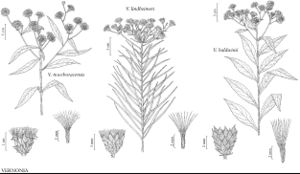Difference between revisions of "Vernonia baldwinii"
Ann. Lyceum Nat. Hist. New York 2: 211. 1827.
FNA>Volume Importer |
imported>Volume Importer |
||
| (6 intermediate revisions by 2 users not shown) | |||
| Line 6: | Line 6: | ||
|place=2: 211. 1827 | |place=2: 211. 1827 | ||
|year=1827 | |year=1827 | ||
| + | }} | ||
| + | |special_status={{Treatment/ID/Special_status | ||
| + | |code=F | ||
| + | |label=Illustrated | ||
| + | }}{{Treatment/ID/Special_status | ||
| + | |code=E | ||
| + | |label=Endemic | ||
}} | }} | ||
|basionyms= | |basionyms= | ||
| Line 11: | Line 18: | ||
|name=Vernonia baldwinii subsp. interior | |name=Vernonia baldwinii subsp. interior | ||
|authority=(Small) W. Z. Faust | |authority=(Small) W. Z. Faust | ||
| − | }}{{Treatment/ID/Synonym | + | |rank=subspecies |
| + | }} {{Treatment/ID/Synonym | ||
|name=Vernonia baldwinii var. interior | |name=Vernonia baldwinii var. interior | ||
|authority=(Small) B. G. Schubert | |authority=(Small) B. G. Schubert | ||
| − | }}{{Treatment/ID/Synonym | + | |rank=variety |
| + | }} {{Treatment/ID/Synonym | ||
|name=Vernonia interior | |name=Vernonia interior | ||
| − | |authority= | + | |authority= |
| + | |rank=species | ||
}} | }} | ||
|hierarchy=Asteraceae;Asteraceae tribe Vernonieae;Vernonia;Vernonia baldwinii | |hierarchy=Asteraceae;Asteraceae tribe Vernonieae;Vernonia;Vernonia baldwinii | ||
| Line 41: | Line 51: | ||
-->{{#Taxon: | -->{{#Taxon: | ||
name=Vernonia baldwinii | name=Vernonia baldwinii | ||
| − | |||
|authority=Torrey | |authority=Torrey | ||
|rank=species | |rank=species | ||
| Line 55: | Line 64: | ||
|publication title=Ann. Lyceum Nat. Hist. New York | |publication title=Ann. Lyceum Nat. Hist. New York | ||
|publication year=1827 | |publication year=1827 | ||
| − | |special status= | + | |special status=Illustrated;Endemic |
| − | |source xml=https:// | + | |source xml=https://bitbucket.org/aafc-mbb/fna-data-curation/src/2e0870ddd59836b60bcf96646a41e87ea5a5943a/coarse_grained_fna_xml/V19-20-21/V19_267.xml |
|tribe=Asteraceae tribe Vernonieae | |tribe=Asteraceae tribe Vernonieae | ||
|genus=Vernonia | |genus=Vernonia | ||
Latest revision as of 19:50, 5 November 2020
Plants 6–10(–15) dm. Stems puberulent to ± tomentose. Leaves mostly cauline; blades elliptic to lance-ovate or lanceolate, 8–15(–18+) cm × 20–45(–75+) mm, l/w = 2–5, abaxially usually puberulent to tomentose or pannose (hairs ± erect, ± curled), seldom glabrate, resin-gland-dotted, adaxially scabrellous, glabrescent, not resin-gland-dotted. Heads in corymbiform-scorpioid arrays. Peduncles 1–25 mm. Involucres broadly campanulate to hemispheric, 4–6(–8+) × 4–7+ mm. Phyllaries 45–65+ in 5–6 series, usually puberulent (often resin-gland-dotted distally), sometimes glabrescent, margins ciliolate, the outer lance-ovate, 1–2 mm, inner oblong to lanceolate, 5–8+ mm, tips rounded-apiculate to acute (sometimes recurved). Florets (15–)20–25(–35+). Cypselae 2.5–3 mm; pappi fuscous to purplish, outer scales 25–30, 0.2–1 mm, contrasting with 35–40+, 5–7+ mm inner bristles. 2n = 34.
Phenology: Flowering Jun–Nov.
Habitat: Disturbed places, grasslands, flood plains, forest margins, prairies
Elevation: 10–1100 m
Distribution

Ark., Colo., Ill., Iowa, Kans., Ky., La., Mich., Mo., Nebr., Okla., Tex.
Discussion
Regarding Vernona baldwinii and V. interior, L. H. Shinners (1950) wrote, “The tips of the phyllaries vary from loosely appressed to squarrose, and from puberulent to almost completely glabrous on the inner face. The geographic distribution of the two extremes is nearly identical. I consider the two to be merely forms of one species.” I concur.
Selected References
None.
